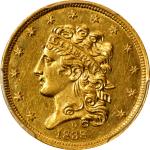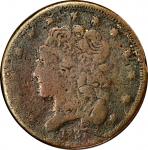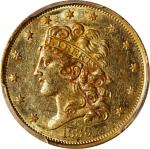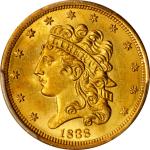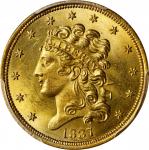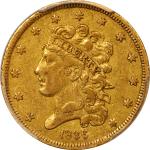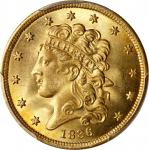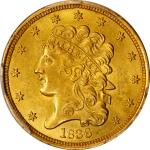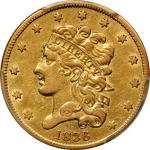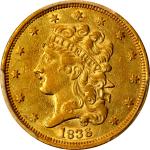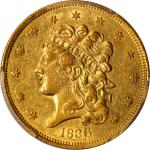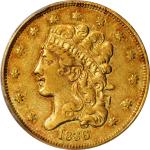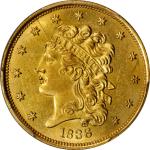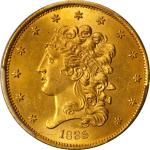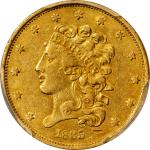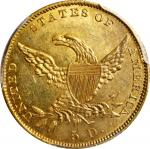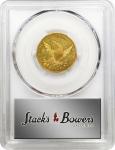1838-C Classic Head Half Eagle. HM-2, Winter-2. Rarity-5. MS-63 (PCGS). <strong>Die Variety:</strong> HM-2. Obverse 1: The only obverse die of the 1838-C half eagle issue, with a tall 1 and block 8s in the date. The C mintmark is positioned above the left side of the digit 3. Reverse Q: The second highest leaf in the branch nearly touches the base of the letter U in UNITED and the digit 5 in the denomination is repunched. These features are sufficient to distinguish this die from the only other reverse of the issue. Reverse Q appears in no other pairings in the half eagle series.<p><strong>Die Emission Sequence: </strong>Although not verified by other numismatic scholars, Walter Breen asserts that the die pairing now attributed as HM-2 represents the first struck for the 1838-C half eagle.<p><strong>Die State: </strong>The obverse die has been boldly polished, removing much of the detail from the back of Libertys head and hollowing that region and the letters ERTY in LIBERTY against the reflective backdrop. Libertys mouth appears agape. The reverse has also been lapped, opening the details around the talon at left, at the feathers left of the shield, and at the border of the eagles neck and shield below. The reverse die is uncracked, an unusual and rare early state for the 1838-C HM-2 attribution. Most examples of this variety show a strong diagonal crack on the reverse, from lower left to upper right. Since no partial die crack examples are known, Daryl J. Haynor concludes that this break was sudden and severe.<p><strong>Estimated Surviving Population for the Variety:</strong> 63 coins in all grades (per Daryl J. Haynor, 2020), or 36% of extant 1838-C Classic Head half eagles.<p><strong>Strike: </strong>Remarkably well produced by Charlotte Mint standards, both sides exhibit virtually full striking detail that comes up short at only a few of the obverse stars, which lack complete radials.<p><strong>Surfaces: </strong>Luster abounds on both sides, highly satiny on the obverse but cartwheeling more evenly on the reverse. The fields of both obverse and reverse show attractive reflectivity, contrasting pleasantly with the well struck devices. The freshness of the surfaces is barely diminished by the presence of light hairlines and scattered light marks. A short scratch crosses star 5, and a tiny nick is noted high on Libertys cheekbone; on the reverse, a series of faint abrasions are seen in the field beneath the word OF. These features, trivial in the extreme on such a well preserved and visually appealing C-Mint half eagle are mentioned solely to aid in establishing this coins provenance. Vertical polish lines on the planchet remain evident on both sides; these are as made.<p><strong>Commentary: </strong>The first Charlotte Mint half eagles were struck on March 28, 1838. In a letter dated April 4, 1838, Mint Director Robert Maskell Patterson confirmed this event to Treasury Secretary Levi Woodbury:<p><em>"I have the pleasure to inform you that I have this day received, from the Branch Mint at Charlotte, a well executed half-eagle, struck there on the 28th ult., and the first of their coinage. It is exactly like those coined at this Mint, except in having the letter C under the head of Liberty. The letter D will be used at Dahlonega, and O at New Orleans."</em><p>Inasmuch as some numismatists believe that HM-2 is the first die variety of 1838-C half struck, and the Virginian Collection specimen is a near-fully struck and rare early die state example, one could conjecture that it was the coin sent to the mint director to confirm the new branch mint coinage. At very least it was immediately set aside by someone wishing to commemorate the beginning of coinage operations at the Charlotte Mint.<p>In modern times specialists in Southern gold have elevated this coin to legendary status, one that has earned it hushed tones of respect not only for its quality, but how much space exists between it and the third finest known example of this issue. It was singled out by David Akers in his 1979 book on half eagles as the sole Uncirculated coin he had seen; Akers added, "I have seen only one other that even graded AU-50." A June 2014 blog post by Doug Winter previewing our then-upcoming Pogue sales looked forward to the "sale of the finest known 1838-C half eagle (the Pogue collection contains a gorgeous PCGS MS63)." In our (Bowers and Merenas) Bass II, sale, the coin was lavished with a full page, described as "a lovely cameo with prooflike qualities," graded MS-63 even amidst the more conservative grading environment that characterized that time. An MS-61 (PCGS) specimen once backstopped this coin as third finest known, but following a misadventure, it no longer appears on the <em>Population Report</em>.<p>As the foregoing makes clear, for years this coin held the coveted title of "Finest Known 1838-C Half Eagle." Indeed, it was ranked CC#1 in the 2008 edition of Doug Winters reference on Charlotte Mint gold coinage. Writing more recently, however, Daryl J. Haynor (2020) was able to take advantage of the knowledge that the <em>PCGS Population Report</em> now lists a single MS-63+ for the 1838-C. This is not an unknown grading event or even an erroneous entry in the <em>Population Report</em>, but rather confirms that the CC#1 ranking for this issue has now been claimed by the specimen that, as of 2020, was owned by Doug Winter Numismatics. Formerly from our (Stacks) Spring Sale of April 1978, that coin appears to have been off the market for most of the intervening four decades, thereby remaining under the radar of those conducting Condition Census and provenance work in this series. As this newcomer is from the HM-1 dies, the Bass-Pogue-Virginian Collection specimen is still ranked CC#1 for the 1838-C HM-2 dies. It remains an extraordinary condition rarity for the issue in its entirety, of course, and will forever enjoy legendary status among those who specialize in pre-Civil War era Southern gold. Only two collectors can simultaneously claim ownership of the finest 1838-C half eagles. With an aggressive bidding strategy pursued to the utmost, the winning bidder of this lot will become the next claimant. PCGS# 765269. NGC ID: 25S5. PCGS Population (both die marriages of the issue): 1; 1 finer (MS-63+). The finest certified at NGC is an MS-62. From the Daryl J. Haynor Virginian Collection. Earlier ex our (Stacks) sale of April 1978, lot 853; Superiors Jascha Heifetz Collection sale, October 1989, lot 4378; Andrew Lustig; RARCOA and David W. Akers, Inc.s Chicago Sale, August 1991, lot 987; Harry W. Bass, Jr., via Goliad Corporation (Mike Brownlee); our (Bowers and Merenas) sale of the Harry W. Bass, Jr. Collection, Part II, October 1999, lot 866; D. Brent Pogue Collection; our (in conjunction with Sothebys) sale of the D. Brent Pogue Collection, Part IV, May 2016, lot 4058. The plate coin for the 1838-C HM-2 variety in the 2020 Haynor reference on Classic Gold coinage.

